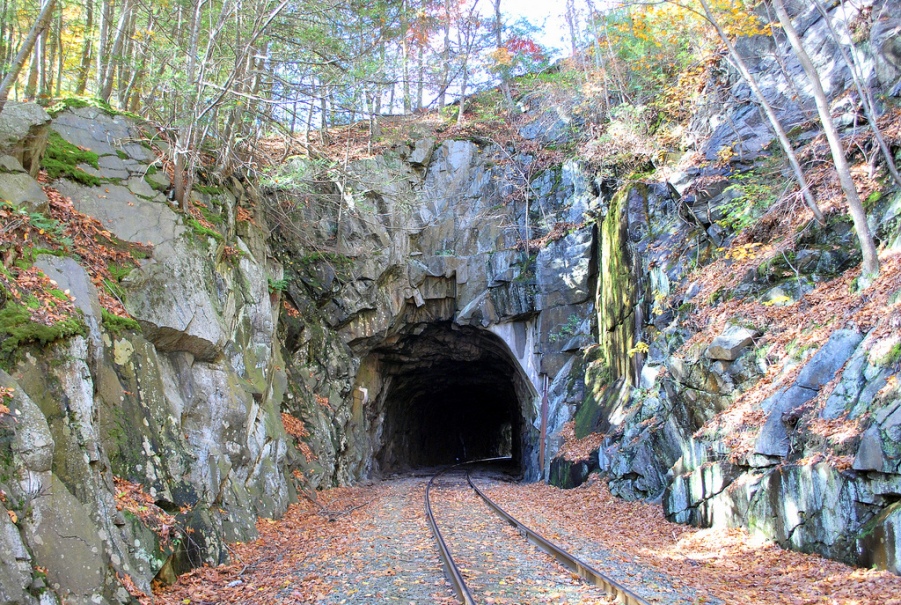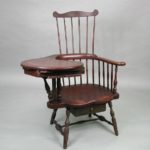
Taft Tunnel completed in 1837, Lisbon – Linda Orlomoski
Named after Portugal’s capital city, the New London County town of Lisbon sits between the Quinebaug and Shetucket Rivers in a National Heritage Corridor popularly known as The Last Green Valley. The town incorporated from Norwich in 1786 and, by the 1800s, its economic base included agriculture as well as wool and silk factories. In 1837, the Norwich-Worcester Railroad cut a tunnel through a hilly section of town along the Quinebaug River. Still in use today, the town claims it as the first railroad tunnel built in the US. Lisbon notables include Ebenezer Tracy, a Revolutionary War-era craftsman known for his Windsor chairs that are today prized by museums and collectors.
Featured
Ebenezer Tracy was a carpenter from Lisbon, Connecticut, who specialized in making fine, hand-crafted furniture. …[more]
Learn More
58529
EE95J4K7
1
apsa
50
default
48819
https://connecticuthistory.org/wp-content/plugins/zotpress/
%7B%22status%22%3A%22success%22%2C%22updateneeded%22%3Afalse%2C%22instance%22%3Afalse%2C%22meta%22%3A%7B%22request_last%22%3A0%2C%22request_next%22%3A0%2C%22used_cache%22%3Atrue%7D%2C%22data%22%3A%5B%7B%22key%22%3A%225BVGCKE9%22%2C%22library%22%3A%7B%22id%22%3A58529%7D%2C%22meta%22%3A%7B%22lastModifiedByUser%22%3A%7B%22id%22%3A14399323%2C%22username%22%3A%22kquotap%22%2C%22name%22%3A%22%22%2C%22links%22%3A%7B%22alternate%22%3A%7B%22href%22%3A%22https%3A%5C%2F%5C%2Fwww.zotero.org%5C%2Fkquotap%22%2C%22type%22%3A%22text%5C%2Fhtml%22%7D%7D%7D%2C%22numChildren%22%3A0%7D%2C%22bib%22%3A%22%3Cdiv%20class%3D%5C%22csl-bib-body%5C%22%20style%3D%5C%22line-height%3A%201.35%3B%20padding-left%3A%201em%3B%20text-indent%3A-1em%3B%5C%22%3E%5Cn%20%20%3Cdiv%20class%3D%5C%22csl-entry%5C%22%3E%26%23x201C%3BLisbon%20Collection.%26%23x201D%3B%20%3Ca%20class%3D%27zp-ItemURL%27%20href%3D%27https%3A%5C%2F%5C%2Fctdigitalarchive.org%5C%2Fislandora%5C%2Fsearch%5C%2Fmods_titleInfo_title_mt%25253A%252528Lisbon%252529%2520OR%2520mods_subject_geographic_mt%25253A%252528Lisbon%252529%27%3Ehttps%3A%5C%2F%5C%2Fctdigitalarchive.org%5C%2Fislandora%5C%2Fsearch%5C%2Fmods_titleInfo_title_mt%25253A%252528Lisbon%252529%2520OR%2520mods_subject_geographic_mt%25253A%252528Lisbon%252529%3C%5C%2Fa%3E.%3C%5C%2Fdiv%3E%5Cn%3C%5C%2Fdiv%3E%22%2C%22data%22%3A%7B%22itemType%22%3A%22document%22%2C%22title%22%3A%22Lisbon%20Collection%22%2C%22creators%22%3A%5B%5D%2C%22abstractNote%22%3A%22%22%2C%22date%22%3A%22%22%2C%22language%22%3A%22%22%2C%22url%22%3A%22https%3A%5C%2F%5C%2Fctdigitalarchive.org%5C%2Fislandora%5C%2Fsearch%5C%2Fmods_titleInfo_title_mt%25253A%252528Lisbon%252529%2520OR%2520mods_subject_geographic_mt%25253A%252528Lisbon%252529%22%2C%22collections%22%3A%5B%22EE95J4K7%22%2C%222MM9363G%22%5D%2C%22dateModified%22%3A%222020-08-28T23%3A45%3A20Z%22%7D%7D%2C%7B%22key%22%3A%2266Z23GBE%22%2C%22library%22%3A%7B%22id%22%3A58529%7D%2C%22meta%22%3A%7B%22lastModifiedByUser%22%3A%7B%22id%22%3A14399323%2C%22username%22%3A%22kquotap%22%2C%22name%22%3A%22%22%2C%22links%22%3A%7B%22alternate%22%3A%7B%22href%22%3A%22https%3A%5C%2F%5C%2Fwww.zotero.org%5C%2Fkquotap%22%2C%22type%22%3A%22text%5C%2Fhtml%22%7D%7D%7D%2C%22parsedDate%22%3A%222017%22%2C%22numChildren%22%3A0%7D%2C%22bib%22%3A%22%3Cdiv%20class%3D%5C%22csl-bib-body%5C%22%20style%3D%5C%22line-height%3A%201.35%3B%20padding-left%3A%201em%3B%20text-indent%3A-1em%3B%5C%22%3E%5Cn%20%20%3Cdiv%20class%3D%5C%22csl-entry%5C%22%3E%26%23x201C%3BThe%20Last%20Green%20Valley.%26%23x201D%3B%202017.%20%3Ca%20class%3D%27zp-ItemURL%27%20href%3D%27http%3A%5C%2F%5C%2Fwww.tlgv.org%5C%2Findex.php%27%3Ehttp%3A%5C%2F%5C%2Fwww.tlgv.org%5C%2Findex.php%3C%5C%2Fa%3E.%3C%5C%2Fdiv%3E%5Cn%3C%5C%2Fdiv%3E%22%2C%22data%22%3A%7B%22itemType%22%3A%22webpage%22%2C%22title%22%3A%22The%20Last%20Green%20Valley%22%2C%22creators%22%3A%5B%5D%2C%22abstractNote%22%3A%22%22%2C%22date%22%3A%222017%22%2C%22url%22%3A%22http%3A%5C%2F%5C%2Fwww.tlgv.org%5C%2Findex.php%22%2C%22language%22%3A%22%22%2C%22collections%22%3A%5B%225WHTZ9GA%22%2C%22P525RKM3%22%2C%22PCNUG9MC%22%2C%22GZIDI3FB%22%2C%225KCFFMDR%22%2C%2299BZ9XTB%22%2C%22D8P8TU99%22%2C%22ED3DTC2E%22%2C%22EE95J4K7%22%2C%22ERK2DIMT%22%2C%22FZ6IR89C%22%2C%22QT3GRRFA%22%2C%22RT22F6HP%22%2C%22VUQ5JHF7%22%2C%22JXK2V4Z5%22%2C%22TPTKTQDC%22%2C%22H3SZX3DN%22%2C%22Q4HVRGT7%22%2C%225ZXKVEE8%22%2C%22J5HW2WBG%22%2C%226S2AT884%22%2C%22TP85WHNN%22%2C%22STFUTMFP%22%2C%22WNUNC86Z%22%2C%225XWRRIFU%22%2C%226G4U6VCT%22%2C%226JJSUFUS%22%2C%22AX8JC6VN%22%2C%22CQR5G4J8%22%2C%22FDKWH4S3%22%2C%22G5UNRD2W%22%2C%22JNJJ3AZV%22%2C%22NFPZ5T2J%22%2C%22XDAMMJCB%22%2C%22ZMGGDP2N%22%2C%22NCJUJ9BQ%22%2C%22ECGISUVG%22%2C%22SEMJ6GM6%22%2C%22G5E2NHIZ%22%2C%22HNG4JX3K%22%2C%22CBF7CTDX%22%2C%22JA8Q7M5E%22%2C%223723QRPC%22%2C%22SKH5ZBRT%22%2C%22TWNPZN7J%22%2C%22RXKFVKRD%22%2C%226S72HRC3%22%2C%2264NZMNMK%22%2C%2288VZVHC4%22%2C%2288B2D7SK%22%2C%22F9ACJX8M%22%2C%22IUW6ZD8P%22%2C%222HEIVWF2%22%5D%2C%22dateModified%22%3A%222017-03-14T20%3A41%3A19Z%22%7D%7D%2C%7B%22key%22%3A%22M4WGQNGU%22%2C%22library%22%3A%7B%22id%22%3A58529%7D%2C%22meta%22%3A%7B%22lastModifiedByUser%22%3A%7B%22id%22%3A14399323%2C%22username%22%3A%22kquotap%22%2C%22name%22%3A%22%22%2C%22links%22%3A%7B%22alternate%22%3A%7B%22href%22%3A%22https%3A%5C%2F%5C%2Fwww.zotero.org%5C%2Fkquotap%22%2C%22type%22%3A%22text%5C%2Fhtml%22%7D%7D%7D%2C%22parsedDate%22%3A%222014%22%2C%22numChildren%22%3A1%7D%2C%22bib%22%3A%22%3Cdiv%20class%3D%5C%22csl-bib-body%5C%22%20style%3D%5C%22line-height%3A%201.35%3B%20padding-left%3A%201em%3B%20text-indent%3A-1em%3B%5C%22%3E%5Cn%20%20%3Cdiv%20class%3D%5C%22csl-entry%5C%22%3E%26%23x201C%3BLisbon%20-%20WPA%20Architectural%20Survey.%26%23x201D%3B%202014.%20%3Ci%3EConnecticut%20State%20Library%20Digital%20Collections%3C%5C%2Fi%3E.%20%3Ca%20class%3D%27zp-ItemURL%27%20href%3D%27http%3A%5C%2F%5C%2Fcslib.cdmhost.com%5C%2Fcdm%5C%2Fsearch%5C%2Fcollection%5C%2Fp4005coll7%5C%2Fsearchterm%5C%2FLisbon%5C%2Ffield%5C%2Ftowns%5C%2Fmode%5C%2Fexact%5C%2Fconn%5C%2Fand%5C%2Forder%5C%2Ftitle%27%3Ehttp%3A%5C%2F%5C%2Fcslib.cdmhost.com%5C%2Fcdm%5C%2Fsearch%5C%2Fcollection%5C%2Fp4005coll7%5C%2Fsearchterm%5C%2FLisbon%5C%2Ffield%5C%2Ftowns%5C%2Fmode%5C%2Fexact%5C%2Fconn%5C%2Fand%5C%2Forder%5C%2Ftitle%3C%5C%2Fa%3E%20%28May%205%2C%202014%29.%3C%5C%2Fdiv%3E%5Cn%3C%5C%2Fdiv%3E%22%2C%22data%22%3A%7B%22itemType%22%3A%22webpage%22%2C%22title%22%3A%22Lisbon%20-%20WPA%20Architectural%20Survey%22%2C%22creators%22%3A%5B%5D%2C%22abstractNote%22%3A%22%22%2C%22date%22%3A%222014%22%2C%22url%22%3A%22http%3A%5C%2F%5C%2Fcslib.cdmhost.com%5C%2Fcdm%5C%2Fsearch%5C%2Fcollection%5C%2Fp4005coll7%5C%2Fsearchterm%5C%2FLisbon%5C%2Ffield%5C%2Ftowns%5C%2Fmode%5C%2Fexact%5C%2Fconn%5C%2Fand%5C%2Forder%5C%2Ftitle%22%2C%22language%22%3A%22%22%2C%22collections%22%3A%5B%22EE95J4K7%22%2C%222MM9363G%22%5D%2C%22dateModified%22%3A%222014-05-05T15%3A43%3A00Z%22%7D%7D%2C%7B%22key%22%3A%22S9KZ4AKR%22%2C%22library%22%3A%7B%22id%22%3A58529%7D%2C%22meta%22%3A%7B%22lastModifiedByUser%22%3A%7B%22id%22%3A14399323%2C%22username%22%3A%22kquotap%22%2C%22name%22%3A%22%22%2C%22links%22%3A%7B%22alternate%22%3A%7B%22href%22%3A%22https%3A%5C%2F%5C%2Fwww.zotero.org%5C%2Fkquotap%22%2C%22type%22%3A%22text%5C%2Fhtml%22%7D%7D%7D%2C%22parsedDate%22%3A%221790-06%22%2C%22numChildren%22%3A1%7D%2C%22bib%22%3A%22%3Cdiv%20class%3D%5C%22csl-bib-body%5C%22%20style%3D%5C%22line-height%3A%201.35%3B%20padding-left%3A%201em%3B%20text-indent%3A-1em%3B%5C%22%3E%5Cn%20%20%3Cdiv%20class%3D%5C%22csl-entry%5C%22%3E%26%23x201C%3BAaron%20Cleveland%20V.%20William%20Ryan%3A%20Cleveland%20Accused%20Ryan%20of%20Kidnapping%20Shoram%2C%20a%20Male%20Negro%20Child%2C%20from%20the%20Family%20of%20Ezra%20Clark%20of%20Lisbon%20and%20Taking%20Him%20to%20South%20Carolina%20to%20Be%20Enslaved.%26%23x201D%3B%201790.%20%3Ca%20class%3D%27zp-ItemURL%27%20href%3D%27http%3A%5C%2F%5C%2Fcslib.cdmhost.com%5C%2Fcdm%5C%2Fref%5C%2Fcollection%5C%2Fp128501coll7%5C%2Fid%5C%2F84%27%3Ehttp%3A%5C%2F%5C%2Fcslib.cdmhost.com%5C%2Fcdm%5C%2Fref%5C%2Fcollection%5C%2Fp128501coll7%5C%2Fid%5C%2F84%3C%5C%2Fa%3E%20%28July%2022%2C%202013%29.%3C%5C%2Fdiv%3E%5Cn%3C%5C%2Fdiv%3E%22%2C%22data%22%3A%7B%22itemType%22%3A%22document%22%2C%22title%22%3A%22Aaron%20Cleveland%20V.%20William%20Ryan%3A%20Cleveland%20Accused%20Ryan%20of%20Kidnapping%20Shoram%2C%20a%20Male%20Negro%20Child%2C%20from%20the%20Family%20of%20Ezra%20Clark%20of%20Lisbon%20and%20Taking%20Him%20to%20South%20Carolina%20to%20Be%20Enslaved%22%2C%22creators%22%3A%5B%5D%2C%22abstractNote%22%3A%22%22%2C%22date%22%3A%22June%201790%22%2C%22language%22%3A%22%22%2C%22url%22%3A%22http%3A%5C%2F%5C%2Fcslib.cdmhost.com%5C%2Fcdm%5C%2Fref%5C%2Fcollection%5C%2Fp128501coll7%5C%2Fid%5C%2F84%22%2C%22collections%22%3A%5B%22EE95J4K7%22%2C%222MM9363G%22%5D%2C%22dateModified%22%3A%222013-07-22T20%3A24%3A29Z%22%7D%7D%2C%7B%22key%22%3A%22PBUXM35Z%22%2C%22library%22%3A%7B%22id%22%3A58529%7D%2C%22meta%22%3A%7B%22lastModifiedByUser%22%3A%7B%22id%22%3A14399323%2C%22username%22%3A%22kquotap%22%2C%22name%22%3A%22%22%2C%22links%22%3A%7B%22alternate%22%3A%7B%22href%22%3A%22https%3A%5C%2F%5C%2Fwww.zotero.org%5C%2Fkquotap%22%2C%22type%22%3A%22text%5C%2Fhtml%22%7D%7D%7D%2C%22creatorSummary%22%3A%22Bishop%22%2C%22parsedDate%22%3A%221903%22%2C%22numChildren%22%3A0%7D%2C%22bib%22%3A%22%3Cdiv%20class%3D%5C%22csl-bib-body%5C%22%20style%3D%5C%22line-height%3A%201.35%3B%20padding-left%3A%201em%3B%20text-indent%3A-1em%3B%5C%22%3E%5Cn%20%20%3Cdiv%20class%3D%5C%22csl-entry%5C%22%3EBishop%2C%20Henry%20F.%201903.%20%3Ci%3EHistorical%20Sketch%20of%20Lisbon%2C%20Conn.%2C%20from%201786-1900%3C%5C%2Fi%3E.%20New%20York%3A%20H.F.%20Bishop.%20%3Ca%20class%3D%27zp-ItemURL%27%20href%3D%27http%3A%5C%2F%5C%2Farchive.org%5C%2Fstream%5C%2Fhistoricalsketch00bish%23page%5C%2Fn9%5C%2Fmode%5C%2F2up%27%3Ehttp%3A%5C%2F%5C%2Farchive.org%5C%2Fstream%5C%2Fhistoricalsketch00bish%23page%5C%2Fn9%5C%2Fmode%5C%2F2up%3C%5C%2Fa%3E.%3C%5C%2Fdiv%3E%5Cn%3C%5C%2Fdiv%3E%22%2C%22data%22%3A%7B%22itemType%22%3A%22book%22%2C%22title%22%3A%22Historical%20Sketch%20of%20Lisbon%2C%20Conn.%2C%20from%201786-1900%22%2C%22creators%22%3A%5B%7B%22creatorType%22%3A%22author%22%2C%22firstName%22%3A%22Henry%20F.%22%2C%22lastName%22%3A%22Bishop%22%7D%5D%2C%22abstractNote%22%3A%22%22%2C%22date%22%3A%221903%22%2C%22language%22%3A%22%22%2C%22ISBN%22%3A%22%22%2C%22url%22%3A%22http%3A%5C%2F%5C%2Farchive.org%5C%2Fstream%5C%2Fhistoricalsketch00bish%23page%5C%2Fn9%5C%2Fmode%5C%2F2up%22%2C%22collections%22%3A%5B%22EE95J4K7%22%2C%22QBXNPMFD%22%5D%2C%22dateModified%22%3A%222013-07-22T20%3A18%3A58Z%22%7D%7D%2C%7B%22key%22%3A%2264RQTT3M%22%2C%22library%22%3A%7B%22id%22%3A58529%7D%2C%22meta%22%3A%7B%22lastModifiedByUser%22%3A%7B%22id%22%3A14399323%2C%22username%22%3A%22kquotap%22%2C%22name%22%3A%22%22%2C%22links%22%3A%7B%22alternate%22%3A%7B%22href%22%3A%22https%3A%5C%2F%5C%2Fwww.zotero.org%5C%2Fkquotap%22%2C%22type%22%3A%22text%5C%2Fhtml%22%7D%7D%7D%2C%22creatorSummary%22%3A%22Marshall%22%2C%22parsedDate%22%3A%221922%22%2C%22numChildren%22%3A0%7D%2C%22bib%22%3A%22%3Cdiv%20class%3D%5C%22csl-bib-body%5C%22%20style%3D%5C%22line-height%3A%201.35%3B%20padding-left%3A%201em%3B%20text-indent%3A-1em%3B%5C%22%3E%5Cn%20%20%3Cdiv%20class%3D%5C%22csl-entry%5C%22%3EMarshall%2C%20Benjamin%20Tinkham%2C%20ed.%201922.%201%20%3Ci%3EA%20Modern%20History%20of%20New%20London%20County%2C%20Connecticut%3C%5C%2Fi%3E.%20New%20York%2C%20NY%3A%20Lewis%20Historical%20Publishing%20Company.%20%3Ca%20class%3D%27zp-ItemURL%27%20href%3D%27http%3A%5C%2F%5C%2Fwww.archive.org%5C%2Fstream%5C%2Fmodernhistoryofn01mars%23page%5C%2Fn5%5C%2Fmode%5C%2F2up%27%3Ehttp%3A%5C%2F%5C%2Fwww.archive.org%5C%2Fstream%5C%2Fmodernhistoryofn01mars%23page%5C%2Fn5%5C%2Fmode%5C%2F2up%3C%5C%2Fa%3E.%3C%5C%2Fdiv%3E%5Cn%3C%5C%2Fdiv%3E%22%2C%22data%22%3A%7B%22itemType%22%3A%22book%22%2C%22title%22%3A%22A%20Modern%20History%20of%20New%20London%20County%2C%20Connecticut%22%2C%22creators%22%3A%5B%7B%22creatorType%22%3A%22editor%22%2C%22firstName%22%3A%22Benjamin%20Tinkham%22%2C%22lastName%22%3A%22Marshall%22%7D%5D%2C%22abstractNote%22%3A%22%22%2C%22date%22%3A%221922%22%2C%22language%22%3A%22%22%2C%22ISBN%22%3A%22%22%2C%22url%22%3A%22http%3A%5C%2F%5C%2Fwww.archive.org%5C%2Fstream%5C%2Fmodernhistoryofn01mars%23page%5C%2Fn5%5C%2Fmode%5C%2F2up%22%2C%22collections%22%3A%5B%22492FUVIJ%22%2C%225KCFFMDR%22%2C%227BX29H87%22%2C%22ED3DTC2E%22%2C%22EE95J4K7%22%2C%22ERK2DIMT%22%2C%22ND8V5JIA%22%2C%226TUINSEH%22%2C%22XMUEQE9I%22%2C%22QBXNPMFD%22%2C%22V9BNM62D%22%2C%226GQ8W85E%22%2C%229PEKRZR9%22%2C%22XRRANWPT%22%2C%22HEEIAVME%22%2C%22EIXHZJS7%22%2C%22KDTMAACW%22%2C%22SB6AXBE6%22%2C%225XWRRIFU%22%2C%22AX8JC6VN%22%2C%22HDAZUBSA%22%2C%22JNJJ3AZV%22%2C%22JNTP4ZQ7%22%2C%22K66KIVTB%22%2C%22QZENF542%22%2C%22R9FU2RJ5%22%2C%22WTBIQ5AX%22%2C%22XDAMMJCB%22%2C%22BFW2JP4W%22%2C%22ENPM632A%22%2C%22AQIJ5WWZ%22%2C%22NRX2JCF2%22%2C%226PGZBMG9%22%2C%22CC48ND8W%22%2C%22ZJWRSPG4%22%2C%22B3BTR9Z9%22%2C%22FMETC2JM%22%2C%22JT5G6UFS%22%2C%228MBV64E6%22%2C%224CIVGKE2%22%2C%22VPJSQGZD%22%5D%2C%22dateModified%22%3A%222013-03-08T14%3A06%3A09Z%22%7D%7D%2C%7B%22key%22%3A%22UMCXJNXB%22%2C%22library%22%3A%7B%22id%22%3A58529%7D%2C%22meta%22%3A%7B%22lastModifiedByUser%22%3A%7B%22id%22%3A14399323%2C%22username%22%3A%22kquotap%22%2C%22name%22%3A%22%22%2C%22links%22%3A%7B%22alternate%22%3A%7B%22href%22%3A%22https%3A%5C%2F%5C%2Fwww.zotero.org%5C%2Fkquotap%22%2C%22type%22%3A%22text%5C%2Fhtml%22%7D%7D%7D%2C%22parsedDate%22%3A%222012%22%2C%22numChildren%22%3A1%7D%2C%22bib%22%3A%22%3Cdiv%20class%3D%5C%22csl-bib-body%5C%22%20style%3D%5C%22line-height%3A%201.35%3B%20padding-left%3A%201em%3B%20text-indent%3A-1em%3B%5C%22%3E%5Cn%20%20%3Cdiv%20class%3D%5C%22csl-entry%5C%22%3E%26%23x201C%3BThe%20Lisbon%20Historical%20Society.%26%23x201D%3B%202012.%20%3Ca%20class%3D%27zp-ItemURL%27%20href%3D%27http%3A%5C%2F%5C%2Fwww.99main.com%5C%2F~chill%5C%2FHistoric.html%27%3Ehttp%3A%5C%2F%5C%2Fwww.99main.com%5C%2F~chill%5C%2FHistoric.html%3C%5C%2Fa%3E.%3C%5C%2Fdiv%3E%5Cn%3C%5C%2Fdiv%3E%22%2C%22data%22%3A%7B%22itemType%22%3A%22webpage%22%2C%22title%22%3A%22The%20Lisbon%20Historical%20Society%22%2C%22creators%22%3A%5B%5D%2C%22abstractNote%22%3A%22%22%2C%22date%22%3A%222012%22%2C%22url%22%3A%22http%3A%5C%2F%5C%2Fwww.99main.com%5C%2F~chill%5C%2FHistoric.html%22%2C%22language%22%3A%22%22%2C%22collections%22%3A%5B%22EE95J4K7%22%2C%224U8MTW9P%22%5D%2C%22dateModified%22%3A%222012-05-12T02%3A19%3A24Z%22%7D%7D%5D%7D
“The Last Green Valley.” 2017.
http://www.tlgv.org/index.php.
“Aaron Cleveland V. William Ryan: Cleveland Accused Ryan of Kidnapping Shoram, a Male Negro Child, from the Family of Ezra Clark of Lisbon and Taking Him to South Carolina to Be Enslaved.” 1790.
http://cslib.cdmhost.com/cdm/ref/collection/p128501coll7/id/84 (July 22, 2013).
Bishop, Henry F. 1903.
Historical Sketch of Lisbon, Conn., from 1786-1900. New York: H.F. Bishop.
http://archive.org/stream/historicalsketch00bish#page/n9/mode/2up.
Marshall, Benjamin Tinkham, ed. 1922. 1
A Modern History of New London County, Connecticut. New York, NY: Lewis Historical Publishing Company.
http://www.archive.org/stream/modernhistoryofn01mars#page/n5/mode/2up.







